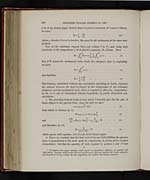Lord Kelvin (1824-1907)
On a method of discovering experimentally the relation between the mechanical work spent, and the heat produced by the compression of a gaseous fluid
290
PROFESSOR WILLIAM THOMSON ON THE
§ 21 of my former paper, derived from CLAUSIUS'S extension of CARNOT'S theory,
we have
[NLS note: a graphic appears here – see image of page]
where μ denotes CARNOT'S function, the same for all substances at the same tem-
perature.
Now let the substance expand from any volume V to V', and, being kept
constantly at the temperature t, let it absorb a quantity, H, of heat. Then
[NLS note: a graphic appears here – see image of page]
But, if W denote the mechanical work which the substance does in expanding,
we have
[NLS note: a graphic appears here – see image of page]
and therefore
[NLS note: a graphic appears here – see image of page]
This formula, established without any assumption admitting of doubt, expresses
the relation between the heat developed by the compression of any substance
whatever, and the mechanical work which is required to effect the compression;
as far as it can be determined without hypothesis, by purely theoretical con-
siderations.
4. The preceding formula leads to that which I formerly gave for the case of
fluids subject to the gaseous laws; since for such we have
[NLS note: a graphic appears here – see image of page]
from which we deduce, by (c),
[NLS note: a graphic appears here – see image of page]
and [NLS note: a graphic appears here – see image of page]
and therefore, by (d),
[NLS note: a graphic appears here – see image of page]
which agrees with equation (11) of § 49 of the former paper.
5. Hence we conclude that the heat evolved by any fluid fulfilling the gaseous
laws, is proportional to the work spent in compressing it, at any given constant
temperature; but that the quantity of work required to produce a unit of heat
* Throughout this paper formulæ, which involve no hypothesis whatever, are marked with
italic letters; formulæ which involve BOYLE'S and DALTON'S laws are marked with Arabic numerals;
and formulæ involving, besides, MAYER'S hypothesis, are marked with Roman numerals.


